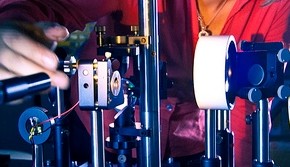World's Smallest Laser is Smaller than Dust
on

What is the biggest constraint in creating tiny lasers? Pump power. Yes sir, all lasers require a certain amount of pump power from an outside source to begin emitting a coherent beam of light and the smaller a laser is, the greater the pump power needed to reach this state. The laser cavity consists of a tiny metal rod enclosed by a ring of metal-coated, quantum wells of semiconductor material. A team of researchers from the University of California has developed a technique that uses quantum electrodynamic effects in coaxial nanocavities to lower the amount of pump power needed. This allowed them to build the world’s smallest room-temperature, continuous wave laser. The whole device is only half a micron in diameter (human hair has on average a thickness of 50 micron).
The nanolaser design appears to be scalable – meaning that they could be shrunk to even smaller sizes – an important feature that would make it possible to harvest laser light from even smaller structures. Applications for such lasers could include tiny biochemical sensors or high-resolution displays, but the researchers are still working out the theory behind how these tiny lasers operate. They would also like to find a way to pump the lasers electrically instead of optically.
Photo Credit: Josh Knoff, UC San Diego Jacobs School of Engineering.


Discussion (0 comments)